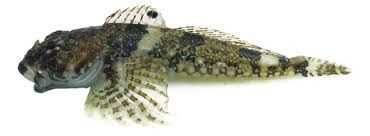Silverspotted Sculpin

Species Details
Blepsias Cirrhosus
Hemitripteridae
Scorpaeniformes
Kelp Beds, Intertidal Pools
1 - 1 lbs.
2" - 8"
Silverspotted Sculpin (Blepsias Cirrhosus) Description
The Silverspotted Sculpin gets its name from the design of its lateral line. Unlike other fish that have a long stripe running across their bodies, the Silverspotted Sculpin has 6-8 silver spots that run across its body. Appearance-wise, the Silverspotted Sculpin has a distinct marker. It has a deeply notched long sail-fin that if you take it out of the water, it looks like a mushy leaf.
The Silverspotted Sculpin appears to be dark olive green in color with some black markings near its face and gills. The posterior dorsal fin and the anal fin appear to be both dark gold whereas its tailfin appears to be greyish blue with dark brown stripes. Although, the color of the tailfin depends heavily on the light. The tailfin of the Silverspotted Sculpin looks similar to a fan.
Diet and Size
Silverspotted Sculpins, like their other Sculpin cousins, are not picky with what they eat. However, they are usually found lingering around kelp beds. Sometimes, they’ll eat prey that is smaller than them or sometimes feeds on algae. Since they’re ambush predators, they’ll pretty much feed on whatever they find.
Silverspotted Sculpins are small. The biggest Silverspotted Sculpin measurement was at 7.87 inches. However, they’re usually 2-4 inches in length. By normal Sculpin standards, the Silverspotted Sculpin is considered “medium” in size. Considering their length, their weight may not even reach a pound. It might be more around an average of 0.25 – 0.3 oz.
Interesting Facts about the Silverspotted Sculpin
- They have a tendency to outrun their prey.
- Unlike the Tidepool Sculpin that decelerates, the Silverspotted Sculpin gets a little too excited when it reaches near its prey.
- Possibly because they’re so small, people usually ignore them. Their dark olive-green color also makes them impossible to find in kelp beds.
- Silverspotted Sculpins are popular in public aquariums.
- Silverspotted Sculpins don’t have swim bladders.
- People can’t eat Silverspotted Sculpins but anglers often use them as bait instead.
Fishing: How to catch a Silverspotted Sculpin
The best way to find them is to follow a trail of otters. Otters love eating Silverspotted Sculpins. They usually have them as a snack if they’re not looking for bigger fish. Because Silverspotted Sculpins are small, using a small hook is a better idea. Usually, a size 32 is small enough for them. They don’t really get that big so sometimes using a big hook isn’t going to help.
As fish that prefer staying near the surface, no need to use a braided line. Light tackle will do in order to catch the Silverspotted Sculpin. As to what kind of bait to use, the best thing to refer to is the area. What kind of small fishes are there? Where exactly did you find them? Sometimes, using some cut up smaller fish might help. Other times, bugs will do the trick. Small cut up worms will do also. Silverspotted Sculpins are not picky.
Now, if you’re just plain lazy and not in the mood to pull out a rod, then sight-fishing will do too. Follow a group of otters or look for some kelp beds. Once you do, you can either use a net to disturb the kelp beds which lead them to your net. Make sure your net has small holes so they can’t escape.
Habitat and Distribution
Silverspotted Sculpins may sometimes stay in intertidal depths or subtidal depths that are around 131 ft. But, other times – they stay in shallow areas. They appear to have a preference for tropical waters, however. They have a long-range from the North Pacific: Sea of Japan to the Bering Sea and to San Simeon, central California, USA.
Another place they appeared in is in Southern British Columbia and the Strait of Juan de Fuca.






